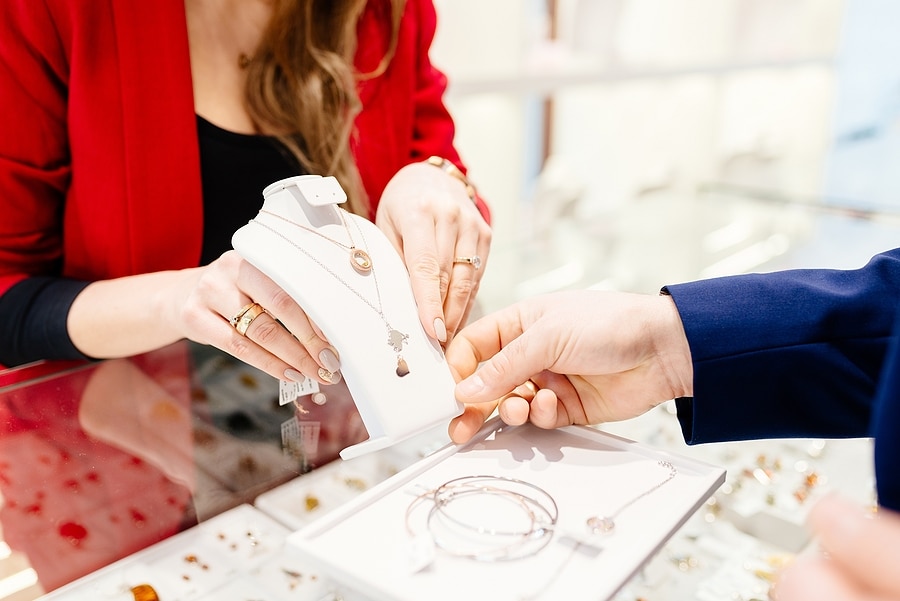By Jewelers Mutual® Group
The number of jewelry thefts reported to the Jewelers’ Security Alliance (JSA) every year remains staggering. According to the most recent JSA annual crime report, crimes committed against jewelers have risen, however, the dollar losses have decreased.
While each incident may represent a small dollar amount when compared to other types of crimes, they can add up fast. If you don’t know what type of criminal behavior to be on the lookout for, these crimes will continue to impact your business and bottom line.
Keep these three common types of jewelry store theft techniques on your radar and get in the habit of practicing preventive measures.

1. Grab-and-Run Theft
Criminals committing this type of crime will typically walk into a store, appearing to browse the merchandise. Usually, they’ll move toward the most valuable merchandise on the showroom floor and ask to see a particular piece. From there, they simply run off with whatever they asked to view.
How do you prevent grab-and-run theft?
Ask to see a customer’s ID before allowing the individual to try on merchandise, no matter what its value is. Once you’ve verified that the ID is legitimate, retain it until the customer has returned the piece. Remember to show an item only after you’ve examined the ID, though. Multitasking can be risky because some grab-and-run attempts have featured suspects taking merchandise directly from the hands of sales associates before the ID was deemed legitimate.
Never show more than one piece at a time. If a customer is adamant about comparing pieces side by side, put one on yourself and let the customer compare. Never have more than two pieces out of your showcases at once, as some criminals are bold enough to attempt grab-and-run thefts with entire trays of rings.
Speaking of being bold: many criminals will appear nervous or fidgety before attempting a grab-and-run. Document suspicious incidents like these so that if the suspect returns, the rest of your staff will know how to properly react.
2. Distraction Theft
These types of thefts often come in waves depending on the activity of criminal groups where multiple people work together. However, they are less common and more difficult to execute.
What is distraction theft?
A group of criminals will work together to overwhelm sales associates to the point where one of the criminals in the group is not attended to and gains access to merchandise. These groups may enter the store together and disperse, or they may enter separately. Although they don’t appear to be colluding, they have probably cased their targeted location numerous times and are coordinating a well-orchestrated effort.
The lengths that these criminals will go to can be very dramatic. They’ve been known to feign illnesses or appear frustrated over poor customer service and cause an uproar. What’s worse, children have also been used as pawns to create distractions for these thefts.
How do you prevent distraction theft?
Greeting every customer who enters your business is a good start—that way, any criminal will know you’re attentive. From there, offer to help them on a one-to-one basis and stay focused on that customer until the individual has left. Politely remind others that you’re in the process of helping someone and will be with them when you’re available.
Lastly, don’t forget to restrict access to your showcases. This means two things:
- Always keep your showcases locked, even when you’re showing merchandise
- Never allow your showcase keys to be accessible to anyone but store associates
3. Smash and Grab
These are often high-profile, brazen attacks that happen quickly and result in high-dollar losses. If you’ve ever seen surveillance footage of one, it almost appears as though nothing could have been done to stop it—but that’s not always the case.
How do you prevent smash-and-grab robberies?
Keep your front doors and windows clear of obstructions, so employees can see suspicious persons outside and passersby can see inside. It’s also a good idea to spread high-value merchandise throughout your showroom and showcases.
Use a video surveillance system that has both overt and concealed cameras. Post signs announcing that you have a surveillance system recording images 24 hours a day, with footage monitored and stored off-site.
Consider installing burglary-resistant glass for your showcase sides, fronts, and tops. This material will slow down an attack. Since robbers want to be in and out as fast as possible, it may even prevent them from accessing your merchandise.
Always have multiple employees on the sales floor. One should always be greeting the customers as they enter, and others should be providing ongoing customer service. An actual customer will enjoy the attention they’ve received, but a criminal might feel uncomfortable and leave.
Remember, your staff will need to repeatedly practice safety tips to form consistent procedural security. Don’t leave their practice to chance—learn more on how you can keep your jewelry store safe by reviewing A Jeweler’s Guide 24/7 Security provided by the loss prevention experts at Jewelers Mutual Group.